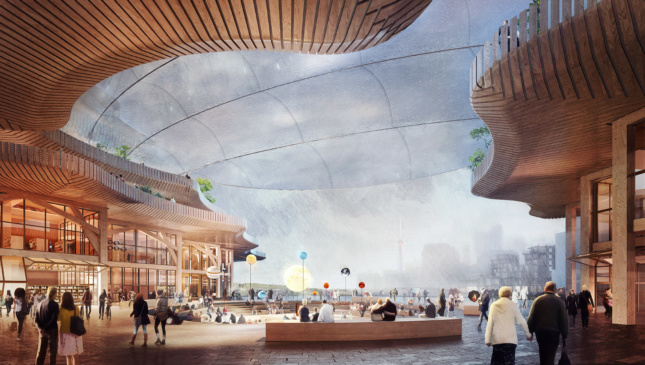In May, Alphabet’s Sidewalk Labs announced that it would cancel its high-profile Quayside project because of “unprecedented economic uncertainty.” The statement marked the end of a three-year initiative to create a living, urban “testbed for emerging technologies, materials, and processes.”
Reversing the traditional order of city planning, Sidewalk Labs imagined building a new urban district on Toronto’s waterfront from the internet up, with sensors and other data collection infrastructure embedded in the fabric of a large city block. The ambitious development—with an area of 2.65 million square feet, including 1.78 million square feet of residential space—was to be built entirely from mass timber; indeed, the extensive use of modular cross-laminated timber (CLT) and glue-laminated timber (glulam) was a chief selling point of the design (by Heatherwick Studio and Snøhetta, using a kit-of-parts developed by Michael Green Architecture).
But the project’s cancellation changes little regarding mass timber’s future. Indeed, the true legacy of the Sidewalk Labs Toronto project lies not in its smart-city applications for human interaction, monitoring, and algorithmic anticipation, but with that much older human activity—wood construction. Mass timber represents a massive step forward for design, carbon-capture goals, and green efficiencies. CLT is as strong as steel and offers the same—or better—fire-retardation properties. It also allows for faster builds (35 percent quicker than typical timelines), which avoids tying up city streets with cement mixers.
From an aesthetic perspective, Quayside was a test case for what’s possible with this innovative material. In the architectural renderings, burnished, almost glowing CLT beams are manipulated into every possible configuration, demonstrating mass timber’s range of applications: skyscrapers, mixed-use developments, higher education. It provided a glimpse of an alternative to the allover concrete that characterizes our contemporary cities, showing communities at work and play against a backdrop of a greener, more open urban canopy of wood and transparent glass.

And lest it be forgotten, the project spoke as broadly to the neighborhood it would serve as it did to the potential of mass timber. Among its stated “community benefits” were employment opportunities for youth, women in construction, and new Canadians, as well as the retraining of military veterans. Beyond its own Toronto waterfront environs, Sidewalk Labs had planned to invest in a mass timber factory that would have employed Indigenous communities in northern Ontario.
We will never know if the promised community integration, social responsibility, and 2,500 new jobs would have materialized exactly as imagined. But all these ideas can be picked up by other developers in Toronto and elsewhere. The legacy of the concept is still there. And so is the notion of creating a mass timber manufacturing sector from scratch in Ontario.
Quayside could have been an urban fountainhead of Canadian building culture and mass timber. Already, it punched above its weight in terms of ambition and connectedness; despite what has been said on the internet, the project as a whole was listening to and observing the world around it—what it could change for the better and where it could adapt to needs.
Those principles—the high-concept intellectual legacy of Sidewalk Labs, along with the advent of mass timber construction—have been bequeathed to the carpenters of Ontario and our other city builders here. Mass timber has not gone away. It is just getting started.
Mike Yorke is president and director of public affairs and innovation for the Carpenters’ District Council of Ontario in Woodbridge.











